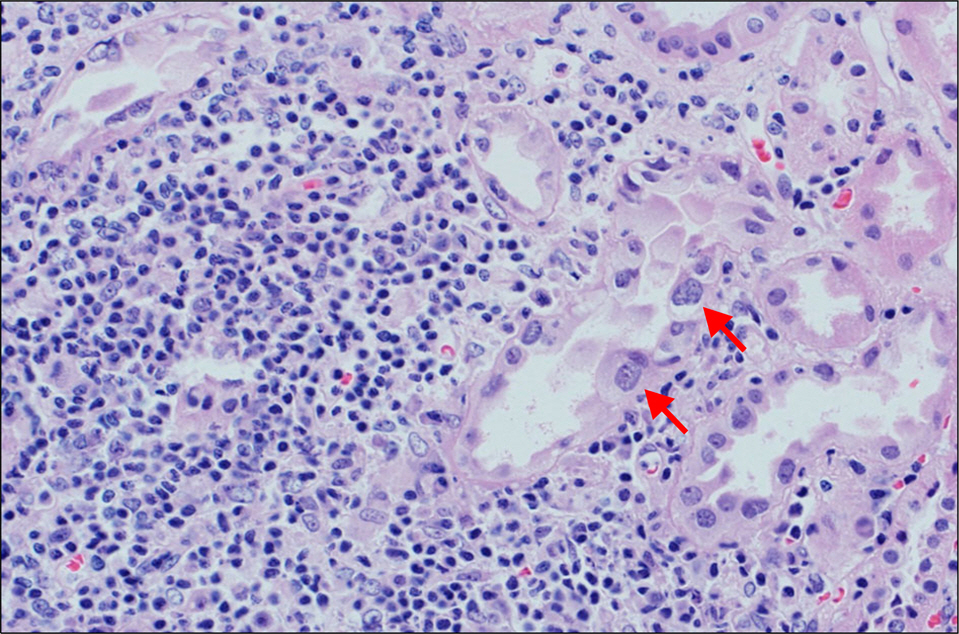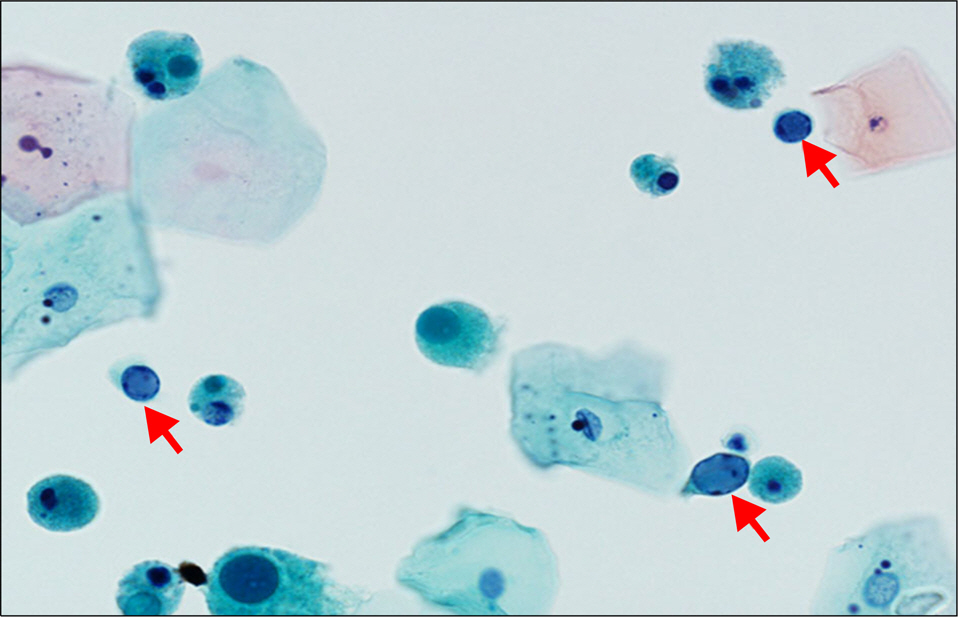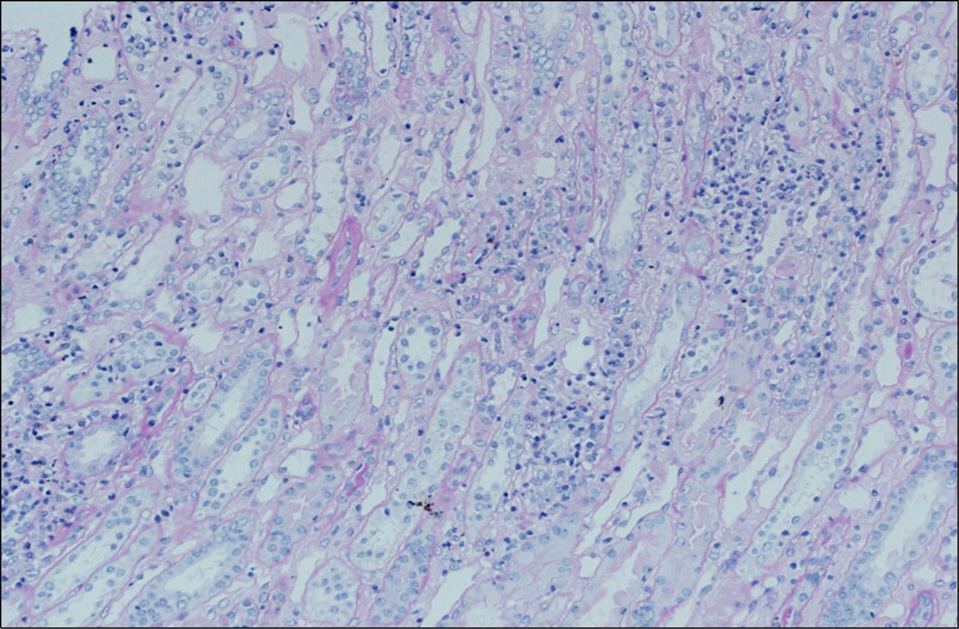J Korean Soc Transplant.
2014 Dec;28(4):254-258. 10.4285/jkstn.2014.28.4.254.
Treatment of Presumptive BK Nephropathy with Ciprofloxain in Kidney Transplant Recipients: Three Case Reports
- Affiliations
-
- 1Department of Internal Medicine, Soonchunhyang University Hospital, Soonchunhyang University College of Medicine, Seoul, Korea. jeonjs@schmc.ac.kr
- 2Department of Pathology, Soonchunhyang University Hospital, Soonchunhyang University College of Medicine, Seoul, Korea.
- KMID: 1941323
- DOI: http://doi.org/10.4285/jkstn.2014.28.4.254
Abstract
- BK virus nephropathy has emerged as an important cause of renal allograft dysfunction. Reduction in immunosuppression is the mainstay of BK virus nephropathy treatment. However, decreasing immunosuppressive medications is not sufficient for treatment of BK virus nephropathy. Therefore, there is a need for other treatment strategies such as cidofovir, leflunomide, and intravenous immunoglobulin in combination with immunosuppression reduction. Ciprofloxacin has recently been reported to have antiviral activity and decrease BK viral load in kidney transplant recipients. These findings suggest that the use of ciprofloxacin represents a valuable treatment strategy in patients with BK virus nephropathy. Here, we report on our experience with three patients who developed presumptive BK virus nephropathy after kidney transplantation, who, after 2 months of ciprofloxacin treatment, showed disappearance of BK viremia and improvement in the estimated glomerular filtration rate. Ciprofloxacin may be considered an effective treatment option for BK viremia in kidney transplant recipients.
Keyword
MeSH Terms
Figure
Cited by 1 articles
-
Delayed Graft Function Is Associated with Microvascular Thrombosis in a Donor with Disseminated Intravascular Coagulation
Yun Ju Cho, Jee Wan Wee, Soon Hyo Kwon, Jin Seok Jeon, Hyunjin Noh, Dong Cheol Han, Dan Song, So Young Jin
J Korean Soc Transplant. 2016;30(1):31-34. doi: 10.4285/jkstn.2016.30.1.31.
Reference
-
References
1). Sawinski D, Goral S. BK virus infection: an update on diagnosis and treatment. Nephrol Dial Transplant. Epub 2014 Feb 25. DOI:. http://dx.doi.org/10.1093/ndt/gfu023.2). Pham PT, Schaenman J, Pham PC. BK virus infection following kidney transplantation: an overview of risk factors, screening strategies, and therapeutic interventions. Curr Opin Organ Transplant. 2014; 19:401–12.3). Masutani K. Current problems in screening, diagnosis and treatment of polyomavirus BK nephropathy. Nephrology (Carlton). 2014; 19(Suppl 3):11–6.
Article4). Kim BS, Kim SH, Kwon KH, Chang HJ, Jeong HJ, Choi KH, et al. BK virus induced interstitial nephritis in renal transplants: diagnosis, treatment and prognosis. J Korean Soc Transplant. 2002; 16:219–26. (김봉수, 김세훈, 권기환, 장한정, 정현주, 최규헌, 등. 신장이식 환자에서 BK 바이러스 감염에 의한 간질성신염: 진단과 치료 및 예후. 대한이식학회지 2002;16: 219–26.).5). Leung AY, Chan MT, Yuen KY, Cheng VC, Chan KH, Wong CL, et al. Ciprofloxacin decreased polyoma BK virus load in patients who underwent allogeneic hematopoietic stem cell transplantation. Clin Infect Dis. 2005; 40:528–37.
Article6). Chandraker A, Ali S, Drachenberg CB, Wali R, Hirsch H, DeCaprio J, et al. Use of fluoroquinolones to treat BK infection in renal transplant recipients [abstract]. Am J Transplant. 2004; 4:587.7). Wojciechowski D, Chanda R, Chandran S, Lee B, Webber A, Macaraig M, et al. Ciprofloxacin prophylaxis in kidney transplant recipients reduces BK virus infection at 3 months but not at 1 year. Transplantation. 2012; 94:1117–23.
Article8). Zaman RA, Ettenger RB, Cheam H, Malekzadeh MH, Tsai EW. A novel treatment regimen for BK viremia. Transplantation. 2014; 97:1166–71.
Article9). Ferrazzi E, Peracchi M, Biasolo MA, Faggionato O, Stefanelli S, Palu G. Antiviral activity of gyrase inhibitors norfloxacin, coumermycin A1 and nalidixic acid. Biochem Pharmacol. 1988; 37:1885–6.10). Josephson MA, Williams JW, Chandraker A, Randhawa PS. Polyomavirus-associated nephropathy: update on antiviral strategies. Transpl Infect Dis. 2006; 8:95–101.
Article11). Drachenberg CB, Papadimitriou JC. Polyomavirus-associated nephropathy: update in diagnosis. Transpl Infect Dis. 2006; 8:68–75.
Article12). Brennan DC, Ramos E. Clinical manifestations and diagnosis of BK virus-induced (polyomavirus-induced) nephropathy in kidney transplantation [Internet]. [place unkown]: UpTo Date;. 2013. [cited 2014 Dec 1]. Available from:. http://www.uptodate.com/contents/clinical-manifestations-and-diagnosis-of-bk-virus-induced-polyomavirus-induced-nephropathy-in-kidney-transplantation.13). Cekmen MB, Bakirdoven S, Sayan M, Yilmaz A. BK virus nephropathy developing after renal transplantation and its treatment with ciprofloxacin: a case report. Transplant Proc. 2012; 44:3044–7.
Article14). Lee BT, Gabardi S, Grafals M, Hofmann RM, Akalin E, Aljanabi A, et al. Efficacy of levofloxacin in the treatment of BK viremia: a multicenter, double-blinded, randomized, placebo-controlled trial. Clin J Am Soc Nephrol. 2014; 9:583–9.
Article15). Humar A, Gill J, Johnston O, Fergusson D, House AA, Lebel L, et al. Quinolone prophylaxis for the prevention of BK virus infection in kidney transplantation: study protocol for a randomized controlled trial. Trials. 2013; 14:185.
Article
- Full Text Links
- Actions
-
Cited
- CITED
-
- Close
- Share
- Similar articles
-
- Characterization of innate immune cell subtypes in kidney transplant recipients with BK virus infection through single-cell transcriptomic profiling of peripheral blood
- High-level viruria as a screening tool for BK virus nephropathy in renal transplant recipients
- BK polyomavirus-associated nephropathy
- Monitoring BK virus infection in pediatric kidney transplant recipients
- BK Virus Detection by Polymerase Chain Reaction in Renal Transplant Recipients and Healthy Donors




